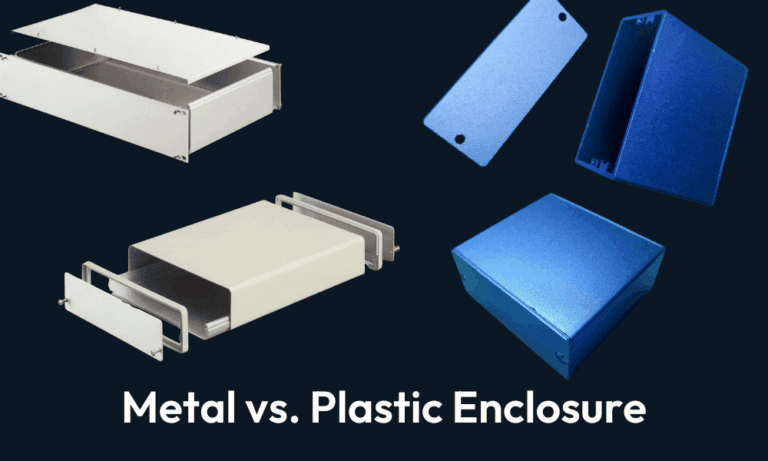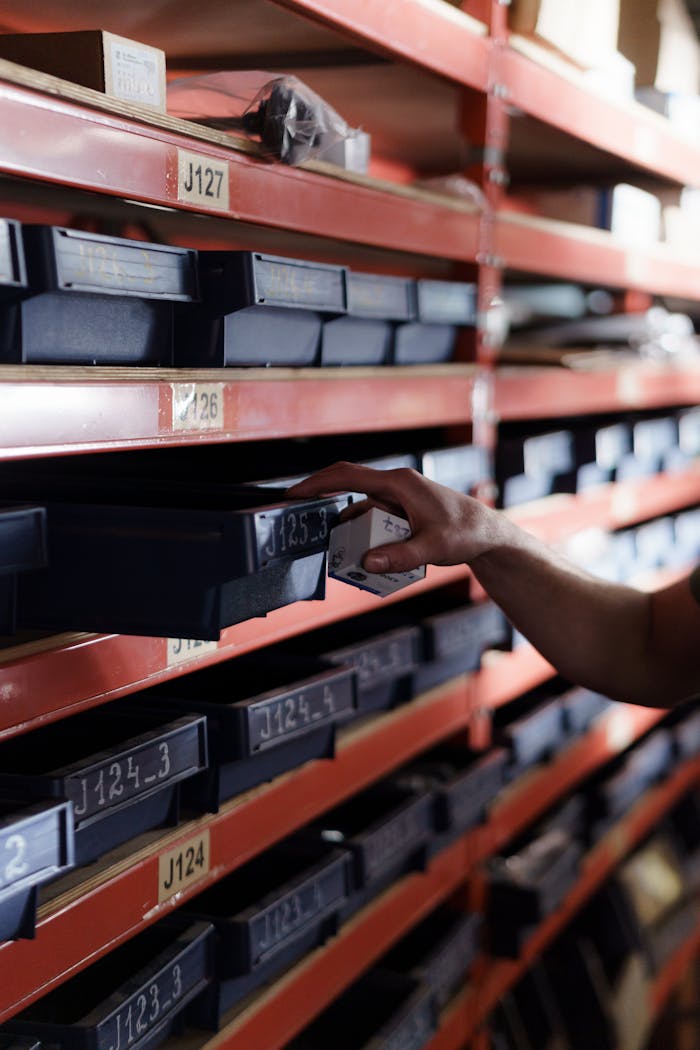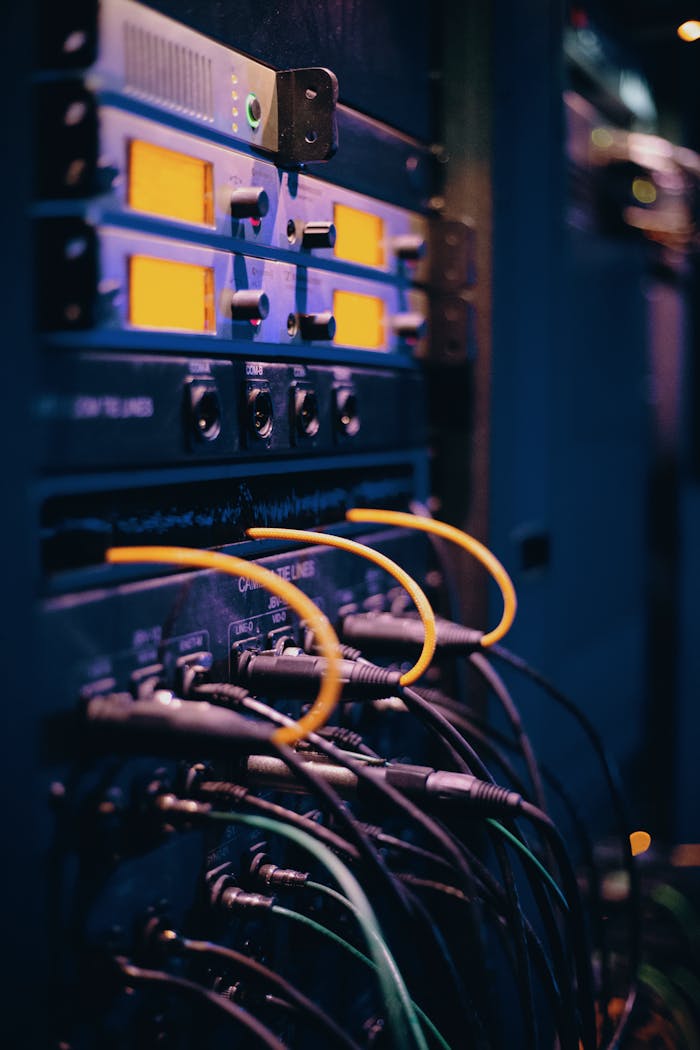Whether you’re designing for aesthetics, performance, or durability, choosing the right material for an enclosure will dictate how it responds to heat, UV rays, corrosion, and signal interference. Matching plastic or metal electronic enclosures to your specific needs is key to turning a good design into a great one.
Most enclosures are made from one of three primary materials: aluminum, plastic, or steel. Each has its strengths and trade-offs, with aluminum combining many of the advantages of the other two.
Factors That Influence Enclosure Material
Selecting the right enclosure material starts with two fundamental questions: What is it protecting, and where will it operate? The intended use of an enclosure — including its environment, application, and internal components — directly influences which material will meet performance, safety, and longevity requirements.
Indoor vs. Outdoor Applications
With their controlled surroundings, reduced exposure to UV rays, and minimal contact with corrosive substances, indoor environments tend to take it easy on electronics. As a result, plastic tends to be a popular choice, especially for devices that rely on Wi-Fi, Bluetooth, or RF communication. However, when thermal management, electromagnetic shielding, or structural strength are required, many manufacturers choose an aluminum enclosure instead.
On the other hand, outdoor electronics face many challenges, such as moisture, UV radiation, temperature swings, and environmental wear and tear. To thrive in these conditions, an outdoor electronic enclosure must be weatherproof and able to resist corrosion. Metal electronic enclosures, like aluminum or stainless steel, is durable and resists rust and oxidation. In particular, aluminum provides these benefits without the added weight of stainless steel and at a lower price point.
Other Considerations: Heat Dissipation
Many electronics pack powerful components into small footprints, which can lead to heat buildup during operation. For high-heat-generating devices, aluminum enclosures regulate internal temperatures by naturally drawing excess heat away from critical components, preventing electrical failures or dangerous incidents like fires. Plastic is usually not used for heat-generating devices because it is a poor conductive material and tends to trap heat instead of transferring it.
Corrosion Resistance
In environments with humidity, salt water, or chemicals, corrosion resistance is an essential feature. An aluminum metal electronic enclosure has an outer oxide layer that naturally resists corrosion, making it ideal for industrial and outdoor conditions.
Signal Transparency
Devices that require wireless connectivity, such as routers and smart home systems, often use plastic enclosures because radio waves can pass through freely. Metal electronic enclosures block wireless signals—which is also a benefit to certain applications. For example, in factories with high electromagnetic interference, metal enclosures work as EMI shielding materials, which protects sensitive electronics from electromagnetic noise.
Plastic Enclosures
Plastic enclosures are often chosen for their lightweight nature and lower cost, particularly when off-the-shelf options are suitable, making them ideal for portable devices or wall-mounted equipment. For some custom enclosures, plastic is selected because it is easy to mold into complex shapes. However, while plastic is typically less expensive than metal, customizations such as molding can become costly unless produced at high volumes (typically thousands of units), which may impact feasibility for smaller production runs.
Design features such as transparent or translucent finishes are another benefit, allowing internal lighting or displays to remain visible through the housing.
That said, plastic has notable limitations. It lacks the durability of metal and can become brittle or degrade over time when exposed to UV radiation, harsh chemicals, or elevated temperatures. Additionally, plastic provides minimal EMI or RFI shielding, which can be problematic in electrically noisy environments.
Steel Enclosures
Steel enclosures provide strength and durability. They are most often found in industrial plants, on manufacturing floors, and in outdoor settings where heavy-duty protection is paramount. Steel has EMI and RFI shielding capabilities, however, this can be a negative feature, too. Steel can block wireless signals, such as Wi-Fi, Bluetooth, and RFID, making it unsuitable for electronics that require wireless communication. Steel is also very heavy, which tends to increase shipping, installation, and maintenance costs.
Standard carbon steel is prone to rust and corrosion when exposed to moisture, salt, or chemicals unless it is properly treated or coated, which adds cost and maintenance considerations. Utilizing stainless steel solves the corrosion problem. However, stainless steel enclosures are significantly more expensive than other metal options and are still considerably heavy.
Aluminum Enclosures – A Balanced Solution
Aluminum enclosures meet the demands of many modern applications. Aluminum is a strong choice for those wanting metal electronic enclosures due to its cost-effectiveness and lighter weight compared to most other metals, an important advantage for countertop equipment, wall-mounted units, and mobile devices. It also has a natural ability to conduct and release heat, which helps electronics operate at safe temperatures without relying too much on cooling systems.
Unlike plastic, which can warp, crack, or degrade in tough conditions, aluminum is resilient in a wide range of environments.
Additionally, aluminum offers excellent EMI (electromagnetic interference) shielding, helping protect sensitive electronic components from interference that could affect performance. While plastic enclosures are great for wireless signals, they leave electronics exposed to environmental noise.
Aluminum is also very cost-effective. The price for an aluminum enclosure is typically lower than stainless steel. While it can cost more than basic plastic, aluminum offers long-term value by minimizing maintenance.
Finally, aluminum enclosures are better for the environment and more sustainable than plastic. It can be recycled indefinitely with minimal loss of quality, meaning aluminum has a higher recycling return rate and lower environmental impact compared to plastic.
Lansing Enclosures
For enterprises requiring quality metal electronic enclosures, Lansing Instrument Corp. offers two families of pre-engineered aluminum enclosure options, MicroPak and GrayBox. GrayBox enclosures are ideal for rack-mounted and free-standing applications, while MicroPak is suited for compact, portable, and handheld applications.
Both series are designed to leverage aluminum’s natural advantages—providing lightweight strength, excellent heat dissipation, corrosion resistance, and superior EMI shielding—making them a reliable choice for a wide range of applications. To learn more about Lansing’s configurable product lines, and how they can meet your electronics housing needs, please contact us.



